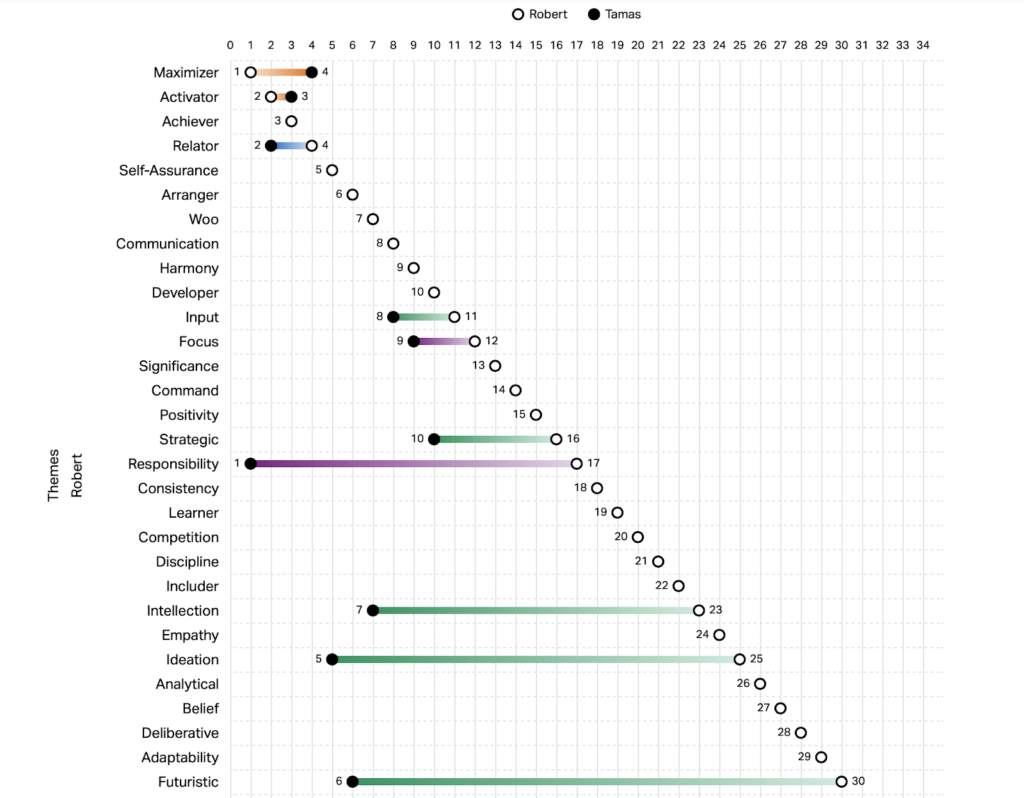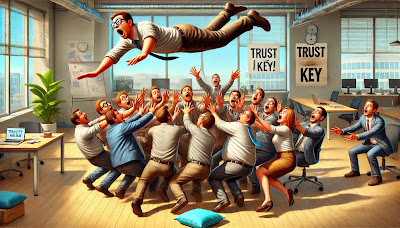Another common approach involves learning more about each other on the management team using a colour-coded test or something similar resulting in a four-letter label for each member. That way, you might better understand why your “red” teenage daughter just screamed at you again after you asked an innocent question after school.
I’m not saying these approaches are entirely pointless; any opportunity for team members to spend time together outside of work, share experiences, and talk has value. Even a shared dinner, drinks or a business trip could suffice — and these actually are all absolutely useful, by the way. However, there are slightly deeper approaches as well, or ones where the work context makes the program much more relevant, and where the practical application of insights is far more likely.
Our Behavioural Change Program for Team Cohesion, aimed at strengthening cooperation within the leadership team, uses a two-pronged approach. One focuses on strength-based collaboration development, and the other on working together towards a shared, cohesive goal, while we also address various dysfunctions in team dynamics. In this post, I’ll share some thoughts on the first approach, illustrated with a personal example.
Strength-Based Collaboration: Insights and Practice
In the above program, we use Gallup’s CliftonStrengths assessment to identify participants’ talent themes, articulate their strengths, and introduce strength-based work practices to enhance team collaboration. Beyond individual and team-level discussions of the CliftonStrengths report results, we also explore how closely collaborating colleagues’ talent themes can either ease cooperation or hinder it. This heightened awareness greatly supports leaders in working together more effectively and tolerating each other better.
Let’s take a practical example: comparing the most dominant talent themes of my colleague, Dr. Róbert Dobay, with my own. It’s crystal clear where we move forward together like a hot knife through butter, where we complement each other pretty well, and what areas might drive each other crazy — requiring extra attention to ensure long-term, effective cooperation.
Here’s the comparison (top: Robert’s dominant themes, empty circles show his rank; beside them, filled circles indicate my rank for each theme):

Synergy and Potential Pitfalls
It’s evident that three of our Top 5 talent themes overlap, making collaboration between us remarkably easy. Both of us are Maximizers, striving not only for personal excellence but also for the quality of our products and team members. You’ll never hear us say, “Good enough will do.” We are both Activators, go-getters: “No messing around — let’s just get the ball rolling!” We avoid actionless talk; if something is discussed, we either consciously let it go or act on it — today, tomorrow, or at a specific later time scheduled in our calendars. We also share Relator, building meaningful connections with people we find valuable, avoiding superficiality. Naturally, if one of us were less demanding or had a more laid-back style, we’d likely drive each other nuts in no time.
Further down, but still within our Top 10, we both have Input and Focus. While these aren’t our strongest talents, we can muster them when needed, so no significant friction tends to arise here.
However, the middle and bottom of the list present a potential minefield: four areas where our talent themes differ significantly. My top themes include Responsibility, Ideation, Futuristic, and Intellection, which rank between 17th and 30th for Robert. My rigidity in certain matters and tendency to float “above the clouds” in other areas might drive him crazy. But instead of dwelling on this, we distribute tasks in ways that allow us to complement each other as business partners. In simple terms, I generate ideas and develop products, while Robert filters them and pursues the ones he sees potential in, taking them to market, presenting them to clients, sparking their interest, and often leading the process to closing deals. Given his own Maximizer talent, he actively gets involved in the final stages of product development to ensure we deliver the best possible offering to our clients.
Robert’s Top 5 also includes Achiever and Self-Assurance, which complement my strengths perfectly. This is why he takes care of all business matters, consulting me only when needed. If he can or wants to decide something on his own, he doesn’t even involve me. Additionally, Robert has Arranger in his Top 10, a theme I lack entirely. Once I propose the “what,” he figures out the “how.” Two other notable strengths of his are Woo and Communication, which are invaluable for our team. Robert heads our business development efforts, delivers conference speeches, and represents our company both locally and internationally. Although I can step into these roles when needed, they don’t play to my dominant strengths (I can do but don’t enjoy them), whereas Robert excels at all of these.
Strategic Thinking and Forward Planning
In Strategic Thinking, we’re not far apart, and we build on this consciously. Along with our colleague, László Filep, whose Futuristic talent is particularly strong, we retreat to an offsite partners’ meeting at least twice a year to chart the way forward.
Well, this is the level of depth at which collaboration can be enhanced among colleagues partnering closely, through a strength-based approach, consciously distributing tasks to leverage each other’s strengths. We don’t even have job titles in our team; instead, we focus on strengths and preferences. For example, among our senior team members, we assign tasks based on who is strongest in and enjoys a particular activity. Naturally, everyone also takes on some tasks they might not love or be particularly good at but need to get done. However, if we work to our strengths 70% of the time, that’s already pretty awesome.
I hope these personal examples provided some insight into strength-based work and collaboration development. It’s a highly effective way to boost efficiency, effectiveness, and employee engagement.
Act2Manage Application
An interactive, gamification-based, practice-oriented leadership development application that provides immediate help and enables follow-up to the most common dilemmas.







